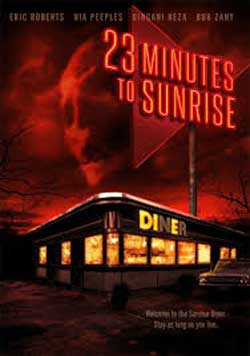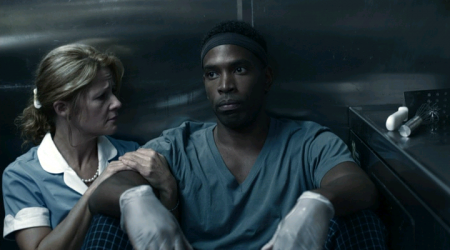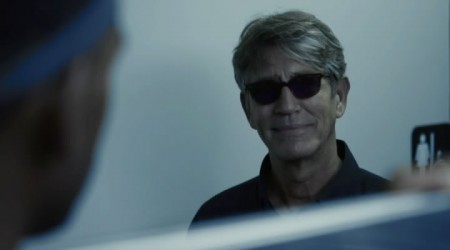Jay Kanzler, the director of 23 Minutes to Sunrise, has taken the time to answer some of our questions in this latest interview. Below you’ll learn a bit about Kanzler’s previous work, what it was like working with actors like Eric Roberts and Bob Zany, the process of getting a feature film shot in ten days, and even some news regarding future projects. Take a look:
What inspired you to write 23 Minutes to Sunrise?
The script for “23 Minutes” was based upon a story idea from Patrick Pinkston. I loved the concept and we set out to turn the story into a script.
I put myself through college working in restaurants, so I felt very comfortable with the setting. And the idea of whether anyone would want everlasting life fascinates me (I still don’t know whether I would want it or not).
How did you go about developing the idea? What was the time frame between initial notes to shooting script?
We moved very quickly. From story to script was about eight weeks. We started shooting ten weeks later. We were working around the schedules for several of the actors, so the project moved faster than we imagined it would.
The process of building on the initial idea, the treatment, the script, putting together a package, and securing funding — what was that like? Did you hit any stumbling blocks?
The initial idea was to shoot the film without any known stars and on an absolute shoestring budget—kind of a festival-only film.
But as we started to put together the cast and crew, we started asking, “What if?” What if we had even a modest budget? What if we could get one or two better known actors to play key roles? What if we could put together a cast and crew that really believed in the project? Then what?
Things really started happening fast, and because we were really building this project from the ground up, a lot of people had to perform multiple roles. I was the co-writer, director, executive producer, and sometimes drove the trailers to and from the set. I was still finding investors even after we started filming. My director of photography, Chris Benson, acted also as a producer, set designer, and many times, as a co-director. The first assistant camera—hired two days before shooting started—had to drive 18 straight hours from Florida to reach the set (delayed six hours along the way by a broken water pump in his car somewhere around Atlanta). Most everyone on the crew did two or three jobs. It was the only way we could shoot the film in ten days.
How did Eric Roberts get attached to the project? What was it like working with him?
Everyone on the film was great to work with, but having Eric Roberts was really something special. We were filming from 5:00 at night until 5:00 in the morning. We had ten days to complete a feature film, and there were some stressful moments. Yet each time, Eric was the first person to step up, keep the morale high, entertain the crew, and then snap right back into character when the camera began to roll. He could easily have played the star card and made a tough situation tougher, but he never did. Just the opposite. He could not have been more professional or more patient with the cast and crew.
I was very lucky to land Eric for the role. He was actually my first choice, and I reached out directly to his wife about whether he might consider the part. She, too, was great and got the script to him. He liked it and agreed to do the film. Interestingly, it has become kind of a family project for Eric and his wife, Eliza. Eric’s stepson (Eliza’s son) Keeton Simons, who is a fantastic musician and singer, performs two of the songs in the film.
This is your first feature-length narrative. What was the transition like? Was there anything new you had to learn or relearn?
Before “23 Minutes,” my concentration was on documentary films. I had directed a couple of shorts, including one animated short film, but nothing close to a feature-length narrative. I had to learn everything, and so, I surrounded myself with people who knew what they were doing and I listened to them. It was a very open set in that regard. If someone had an idea to make the film better, regardless of whose idea it was, we all listened. It was a great experience.
We know you worked on Close But No Cigar: Bob Zany. What was it like working with Bob on 23 Minutes to Sunrise?
Bob Zany is a great actor. He is a good friend of mine as well, so he was going to get a role in the film. But frankly, I did not expect that he would absolutely nail the character the way he did. Part of that might have been because he was playing opposite Nia Peeples, and Bob and Nia went to high school together in West Covina, California. We interviewed Nia for the documentary “Close But No Cigar,” and I saw the chemistry between the two during that interview. Because of their friendship, Nia agreed to play the role of Bob’s wife. Some of their scenes were my favorite scenes to direct. And, of course, Bob Zany the comedian is always “on,” so those were very entertaining evenings on the set.
Eric Roberts, Nia Peeples, Bob Zany, and the rest of the cast in the diner for most of the movie: Did anything interesting or funny happen that is worthy of note?
At one point we were filming the dramatic finale. It was very late at night, and because of the nature of the scene, the cast and crew were a little on edge. In the scene, one of the characters is holding a woman hostage in the restaurant and threatening to kill her, tables are being turned over, and people are hiding behind the lunch counter in the restaurant. It is a very intense scene. During one take, Bob Zany poked his head above the lunch counter, looked into the camera, and improvised: “I’m sorry, I ordered a hot dog, not a hamburger.” It was very funny and probably just the break we needed to take at the moment.
Many movies seem to stumble towards middle. Since the majority of the film takes place in the diner, how difficult was it to properly pace and keep it entertaining? How did you accomplish that?
It was important to try and keep the story moving throughout. We did that by moving from one part of the restaurant to another and by cutting back and forth to the ongoing subplots between the individual couples. We also added some moments of dark humor.
A painful part of being a director is cutting, whether it is omitting scenes from the script in pre-production or cutting in post. Was there anything you wanted to do but couldn’t? Or anything you did do that didn’t make the final cut?
In this case, we did not cut much from what was shot. All of the painful decisions took place in pre-production. We had ten days to shoot the film—that’s it. So several ideas about how we might fill in the characters’ back stories, including the time immediately before their appearances in the diner and after they left the diner, just weren’t possible. You make the very best film you can, given the constraints of time and money.
What would you say was the most rewarding experience of working on the movie?
This was three dozen people all working toward the same goal. It could never have happened otherwise. I am very proud of what we accomplished and was extremely lucky to have made some great friends along the way.
We know you’re involved with Johnnie Be Good, a look at rock legends Johnnie Johnson and Chuck Berry. Do you have any additional projects we can look forward to in the near future?
I am currently in discussions to direct two new independent films. I also have another script based upon a true story involving a case I handled for a client, proving that her daughter had been murdered by her husband five years before and uncovering a gruesome past life of the husband along the way. I plan to produce and direct that film, Preacher Man, and we are talking with several people to play lead roles in the film***
23 Minutes to Sunrise is currently available on Amazon, NetFlix, Blockbuster, RedBox, and elsewhere around the country, so be sure to check it out
 Horror News | HNN Official Site | Horror Movies,Trailers, Reviews
Horror News | HNN Official Site | Horror Movies,Trailers, Reviews



